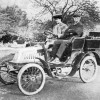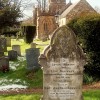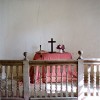Winterborne Stickland, together with the closely associated Winterborne Houghton, are two of the settlements occupying a chalkland valley on the edge of Blackmoor Vale between Blandford and Milton Abbas. The forename Winterborne refers to a seasonal spring which dries up in summer; Stickland, means “the dweller at the steep path” (from the old English sticol or stickel, meaning steep.) It is likely that the name refers to the Chalky Path, an ancient trackway leading up the hill from the village.
Pevsner records the survival of about 12 prehistoric round barrow burials in the two parishes, indicating human activity, at least for funerary purposes, was taking place from at least the early second millennium BC. But in the centuries following the Norman Conquest the village was peripheral to the estate of Milton Abbey, and grew and prospered as “Winterborn Stikelline” under the influence of the Abbey up until the dissolution.
After the church, the oldest building to survive in the village today is Quarlestone Farm. This farm is thought to have been most likely established as a grant of land by William I, though it is first mentioned as being held by William Quarel in 1232. Later it became the home of the Skinner family, Thomas Skinner being interred in the church. The farmhouse is L-shaped with a rendered façade, and the north range incorporates an early hall assigned to the early 15th century.
There are no original window settings in this farmhouse, so the banded walling cannot be original either. The roof of the hall was constructed with arched braces, but these are now concealed by an inserted floor. The 17th century east range and stair projection, are in alternating ashlar and square flint bands. To see the original flint and stone walls the visitor needs to go to the rear of the farmyard. Today the farmhouse is separated from the farm and its outbuildings.
The parish church of St. Mary’s is mainly 13th century, with a late 15th to early 16th century tower and later re-orderings and alterations carried out in the 18th century. The vicarage was built in brick with flint bands in 1685; a further wing was added in 1768 and further additions were made to the building in the 19th century. Above the main door the coat of arms of the vicar incumbent at the time is displayed. (See our feature about St. Mary’s in the Winterborne Stickland Category.)
Stickland had a brewery, which survived as such until the 1890’s, when it became The Malt House, originally a range of three cottages later converted into a private home. The brewery made use of the pure water of the Winterborne stream, which rises on Bulbarrow, and was formerly run by Hall and Woodhouse before that business moved its operations to Blandford. During the conversion of the Malt House a pair of shoes made for a small child was discovered in an attic, sparking an intriguing mystery with possibly sinister undertones as to who the shoes belonged to and how they came to be there.
Two other important public buildings in the village are the Crown Inn and the village pub, The Shire Horse. Although it has traditionally been an isolated, self-contained community, Stickland has enjoyed good services and supplies, including a store and a good Post Office.
Consequently, the villagers have rarely had to travel as far as Blandford for their provisions. Until about the 1920’s a drainage gully ran down the west side of the village’s North Street.
The village had grown up with a mixture of building types and ages, with vernacular thatched cottages interspersed with more modern housing including some bungalows. Three roads converge at the village green, where the base of an old cross survives. There are also two prominent old lime trees. The northernmost of these trees stands near the church and a cluster of several thatched cottages; more cottages built in courses of red brick and flint stand near the southern lime tree. During the 19th century some Victorian villas were added to the housing stock.
But early photographs reveal that many houses have since been demolished. For instance, next to St. Mary’s there stood a white single-storey building (known as the Terrace) believed to have been the centre of a milling industry. The post office, originally occupying Corner Cottage, was re-located in 1906.
A school to accommodate 130 pupils was opened in 1861, and two Methodist chapels, a Wesleyan and a Primitive, where also established here. However, Whitchurch Chapel was demolished in 1973, and a cottage in The Hollow and two other cottages were demolished in the 1950’s. A serious fire in 1955 destroyed the Church View Stores and a pair of cottages.
In 1896 Mr & Mrs Henry Hambro of Milton Abbey visited the village and gave each household a joint of beef. The memory of this family and the philanthropic gesture behind this unusual event is commemorated in the Pamela Hambro Hall, opened in 1934. Part of the Milton Abbey estate was sold by auction at Blandford Corn Exchange in 1932.
One interesting addition of the 20th century commemorating the local industries is a new village sign set up on the green where the three roads meet. The sign unveiled by the sculptress Elizabeth Frink in 1988, is the work of local craftsmen and portrays brewing, smithing, spinning, button making and working the land.
Stickland suffered in the agricultural depression of the 1870’s, when there was a decline in the population, partly due to northward migration in search of factory work. Indeed the 1881 census returns for Chorley in Lancashire showed that 12 people in that parish working in the cotton mills had come from Stickland. As recently as 1991 that year’s national census recorded a village population of 540, of which 51% were of retirement age or over.
One interesting tradition of Stickland in particular is an extended family with scions or offshoots which has adopted the main name of the village; for example the present parish priest of Quedgeley near Gloucester is only a first generation descendant of a man from Stickland who migrated to South Wales.



